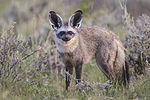Vulpini
| Vulpini | |
|---|---|

| |
| Clockwise from top: red fox, bat-eared fox, tanuki | |
| Scientific classification | |
| Domain: | Eukaryota |
| Kingdom: | Animalia |
| Phylum: | Chordata |
| Class: | Mammalia |
| Order: | Carnivora |
| Family: | Canidae |
| Subfamily: | Caninae |
| Tribe: | Vulpini Hemprich and Ehrenberg, 1832 |
| Genera[1] | |
Vulpini is a taxonomic rank which represents the fox-like tribe of the subfamily Caninae (the canines), and is sister to the dog-like tribe Canini.[2]
Genera
[edit]| Image | Genus | Species |
|---|---|---|

|
Nyctereutes Temminck, 1838 |
|

|
Otocyon S. Müller, 1835 | |

|
Vulpes Garsault, 1764 |
|
| †Ferrucyon Ruiz-Ramoni et al., 2020 | ||
| †Metalopex S. Müller, 1835 |
| |
| †Prototocyon Pohle, 1928 |
Taxonomy
[edit]The taxonomy of Carnivora in general and Canidae in particular correlates with various diagnostic features of the dentition and basicranium. Regarding Vulpini, Tedford has remarked:
These small canids are distinguished from all other Caninae in possessing a wide paroccipital process that is broadly sutured to the posterior surface of the bulla with a short and laterally turned free tip that barely extends below the body of the process. The presence of a metaconule and postprotocrista on M2 of vulpines represents the culmination of a reversal that began with late Leptocyon species to resume the form of the primitive canine M2.
The cladogram below is based on the phylogeny of Lindblad-Toh (2005)[3] modified to incorporate recent findings on Vulpes.[4]
| Vulpini |
| ||||||||||||||||||||||||||||||||||||||||||||||||||||||||||||
References
[edit]- ^ a b Damián Ruiz-Ramoni; Francisco Juan Prevosti; Saverio Bartolini Lucenti; Marisol Montellano-Ballesteros; Ana Luisa Carreño (2020). "The Pliocene canid Cerdocyon avius was not the type of fox that we thought". Journal of Vertebrate Paleontology. 40 (2): e1774889. doi:10.1080/02724634.2020.1774889. S2CID 222214868.
- ^ a b c Tedford, Richard H.; Wang, Xiaoming; Taylor, Beryl E. (2009). "Phylogenetic Systematics of the North American Fossil Caninae (Carnivora: Canidae)" (PDF). Bulletin of the American Museum of Natural History. 325: 1–218. doi:10.1206/574.1. hdl:2246/5999. S2CID 83594819.
- ^ Lindblad-Toh, Kerstin; Wade, Claire M.; Mikkelsen, Tarjei S.; Karlsson, Elinor K.; Jaffe, David B.; Kamal, Michael; et al. (2005). "Genome sequence, comparative analysis and haplotype structure of the domestic dog". Nature. 438 (7069): 803–819. Bibcode:2005Natur.438..803L. doi:10.1038/nature04338. PMID 16341006.
- ^ Zhao, Chao; Zhang, Honghai; Liu, Guangshuai; Yang, Xiufeng; Zhang, Jin (2016). "The complete mitochondrial genome of the Tibetan fox (Vulpes ferrilata) and implications for the phylogeny of Canidae". Comptes Rendus Biologies. 339 (2): 68–77. doi:10.1016/j.crvi.2015.11.005. ISSN 1631-0691. PMID 26868757.


